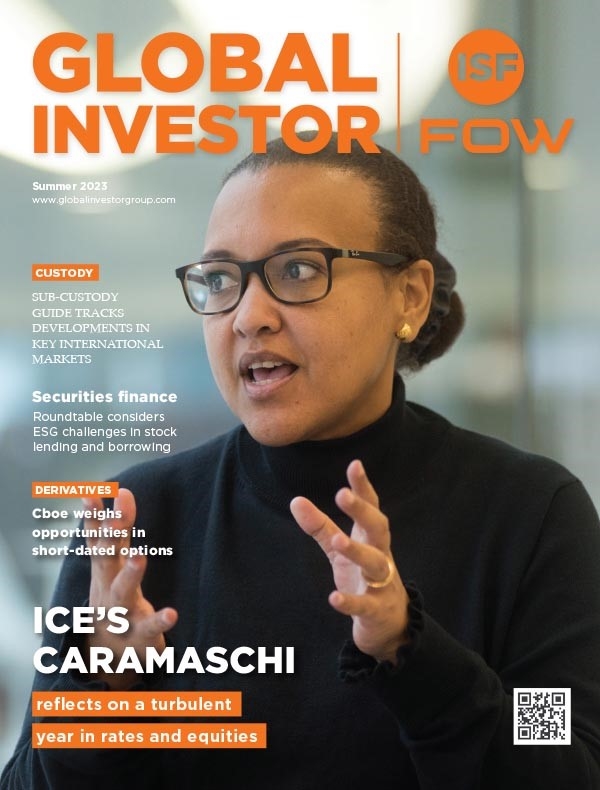Misys: Overcoming the risk challenges of trading fixed income securities
One of the clearest differences between trading equities and fixed income securities is the extent to which analytics play a role in risk management. Equities go up, they go down.
Fixed income securities, however, are subject to numerous parameters such as credit risk, yield-to-maturity, default risk and duration risk to name but a few. Most investors understand equities, yet the vast majority would no doubt struggle to explain the mechanics of fixed income.
This is despite the fact that fixed income strategies – spanning government bonds, sovereign bonds, high-yield corporate bonds, mortgage-backed securities, non-bank loans and emerging market bonds – remain an integral part of investors’ portfolios; typically 40 per cent.
And whilst the debate rages on as to whether a ‘Great Rotation’ from fixed income into equities is now underway in the West, a new white paper by Misys - The ‘Real’ Great Rotation: Analyzing Shifts within Fixed Income & Towards Liability Matching - suggests that the reality is more nuanced.

Rather than rotating fully out of fixed income, investors are looking to their asset managers to find investment opportunities within new realms of fixed income. This can be explained by giving consideration to the demographic profile of developed market investors. Western populations are living longer.
As investors move towards retirement age, the more inclined they are to preserve their wealth by remaining in defensive strategies that can provide them with predictable, relatively risk-free returns with lower volatility than equities.
Romain Mangeret, co-author of the Misys white paper, said: “Diversification within fixed income portfolios helps reduce volatility, at least from a regulatory viewpoint. Also, the move towards electronic trading of bonds on Swap Execution Facilities will add more transparency to the way fixed income securities are traded. These drivers are pushing managers to explore new opportunities, trade new instruments and widen their asset class coverage.”
Combine the fact that people are enjoying longer retirements with the effects of the ’08 financial crisis and this explains why increasingly pension fund investors are mandating asset managers to run liability-driven investment (LDI) strategies in order to meet their funding gaps.
A report by Booz & Co entitled Strategic Opportunities for Asset Managers in US Liability-Driven Investing (LDI) estimates that there is more than USD610bn in AuM globally in LDI strategies.
Emerging market bonds are just one such example of how managers are searching for higher yield. This particular segment now represents 12% of the estimated USD114tn global fixed income market. But in order to respond to investors, asset managers need reassurances that their IT systems can deliver a comprehensive suite of analytics, not to mention pre- and post-trade compliance tools.
Effectively running fixed income strategies can therefore present a number of challenges.
Analytics
The usual analytics required by a portfolio manager include: Key Rate Duration, credit duration, Yield-to-Maturity, Mark-to-Market spread. When the portfolio is being rebalanced, the manager will have a view on the market. In a corporate bond strategy, for example, certain issuers within one sector might be more attractive and the portfolio manager decides to overweight that sector relative to the benchmark.
“When picking a particular issuance with that sector they first need to see how it will contribute to the duration of their portfolio and its sensitivity with respect to long-term or short-term interest rates, then the yield-to-maturity of the issuance and the option-adjusted- spread in order to establish whether or not it will be a good bond to buy,” says Romain Mangeret.
Fixed income managers are constantly required to rebalance their portfolios in response to cash inflows or outflows, and market movements: this requires flexibility and tactical nous. Rarely will a manager simply buy a 10-year bond and hold it to maturity. They require as much information on each security as possible so as to know which bonds to sell, and at what time.
Part of the risk analytics challenge is therefore having the tools in place to run pre-trade simulations: a consolidated view of the portfolio that lets the manager understand what impact new trades/instruments will have on the portfolio before such trades are executed in the market.
This is especially important for portfolio managers who require the use of various derivative instruments, for overlay purposes or to control their hedging strategy in an LDI mandate.
It is hard to match the liability profile (and control the hedging gap) in a long-only fixed income strategy. To overcome this, managers need to use a hedging overlay composed of swaps – specifically interest rate swaps (IRS) and inflation swaps.
“What managers will want in their system is the ability to have a consistent view of their multi-asset portfolio and to understand the effects of the hedging overlay on the portfolio,” says Mangeret, who uses the following example.
“If an asset manager is running a pure interest rate strategy and they find a good issuance that does not match their duration benchmark they might want to hedge the difference with an IRS. This is why at Misys Sophis, we endeavor to deliver technology that not only provides firms with the ability to manage these instruments in a single portfolio but also gives portfolio managers access to the necessary risk analytics to trade both instruments with complete peace of mind.”
Performance
Pricing a bond can often be complex. As most bond portfolios are large and often tied to huge aggregate benchmarks, that pricing exercise can become time consuming as well. Portfolio managers have two choices - either they wait while rebalancing everything within the portfolio, or they base their rebalancing, in real-time, on overnight computations of end-of-day price sensitivities.
Ultimately, managers value performance over precision. The previous day’s price sensitivities are adequate but they need IT systems that generate that real-time view of the portfolio.
“They would rather have instant results on overnight computations than wait 30 minutes to reconstitute everything,” says Mangeret. What differentiates Misys, however, is that if a portfolio manager wishes to trade new instruments, for which overnight computations are not available, they have the ability to re-compute the analytics and trade seamlessly.
Managers are increasingly required to monitor portfolios relative to their benchmarks. This places more emphasis on pre-trade controls and the ability to run simulation workflows to compare results to a stated benchmark. Furthermore, it means that firms must maintain a library of benchmarks with full market data to effectively slice and dice; the US Barclays Agg Index, to illustrate, contains over 8,000 constituents.
Constraints Management
This relates to the pressure managers are under both with respect to external regulatory compliance and their own internal compliance policies.
One of the challenges they face is the ability to rebalance the portfolio in such a way that allows them to check trades against regulatory constraints. By extension, this helps protect against potential style drift; an important consideration when front office teams start to trade more adventurously.
Institutional investors, in particular insurance companies who themselves are coming under regulatory pressure to control their solvency capital ratios, are becoming far more demanding on the level of transparency in their funds they invest in. They want to know how much volatility there is in the portfolio at any given time and as Mangeret comments:
“There will be strict constraints on how much volatility the portfolio is able to incur because at some point the insurer will need to aggregate all the data from all the portfolio managers they have assets invested with to cover their liabilities.”
And it’s not just insurance companies. Increasingly, pension funds are using segregated managed accounts to move away from commingled funds to mitigate risk and keep a closer rein on the manager. This is putting the front office under much more pressure to ensure that all members of the team are working with the same view of the portfolio and monitoring risk analytics at all times.
Addressing the Challenges
To keep on top of these challenges, fixed income managers rely on IT systems like Misys Sophis which give them the flexibility and confidence to trade new instruments and compute all necessary sensitivities in a real-time environment. The system is able to store data overnight or import it from market data feed providers and plug that data directly into the portfolio.
This is necessary for managers who want effective risk management as a way to improve overall fund performance. After all, the quicker they can trade markets and ‘seize the opportunity’ on behalf of their investors the better.
Myriad pricing models can be leveraged within Misys Sophis to achieve this. A manager might shift their attention to Brazilian corporate bonds, use the system’s pre-trade pricing model to determine the impact on the portfolio and trade a selection of instruments with full end-to-end capabilities.
And it’s not just bonds that this applies to.
Other asset classes such as non-bank loans are also supported within Sophis. This asset class is fast gaining traction as global banks deleverage and institutional investors step into the breach to provide loans to corporates. As a yield diversifier, they are becoming highly attractive, especially to insurance companies who want investment products to meet longer-term liabilities.
Eric Léveillé, managing director and head of the Canadian institutional business with BlackRock Asset Management Canada Ltd, wrote on 11th March 2014: “In addition to increasing yield and reducing duration, an allocation to loans can help to diversify a traditional fixed income portfolio, as these assets tend to exhibit low correlations with core holdings such as government and investment grade bonds.”
Mangeret added: “Having a flexible framework to manage credit risk makes it easier for managers to expand into other asset classes within fixed income such as loans. Sophis can support the risk controls needed in monitoring and managing these non-bank loan assets.”
This is what Mangeret refers to as supporting data aggregation across multiple axes i.e. the ability to trade across different asset classes within fixed income to stay ahead of the curve. As LDI strategies and yield pressures push managers into new areas of global fixed income, risk management becomes more complex.
Having an integrated portfolio and risk analytics solution overcomes the challenges of relying on disparate systems and which could potentially give managers an inaccurate view of their portfolio.
Integration, scalability, asset class coverage- these are three clear benefits that Misys Sophis can bring to today’s ambitious fixed income manager. Get the full report at misys.com/insight
Found this useful?
Take a complimentary trial of the FOW Marketing Intelligence Platform – the comprehensive source of news and analysis across the buy- and sell- side.
Gain access to:
- A single source of in-depth news, insight and analysis across Asset Management, Securities Finance, Custody, Fund Services and Derivatives
- Our interactive database, optimized to enable you to summarise data and build graphs outlining market activity
- Exclusive whitepapers, supplements and industry analysis curated and published by Futures & Options World
- Breaking news, daily and weekly alerts on the markets most relevant to you



